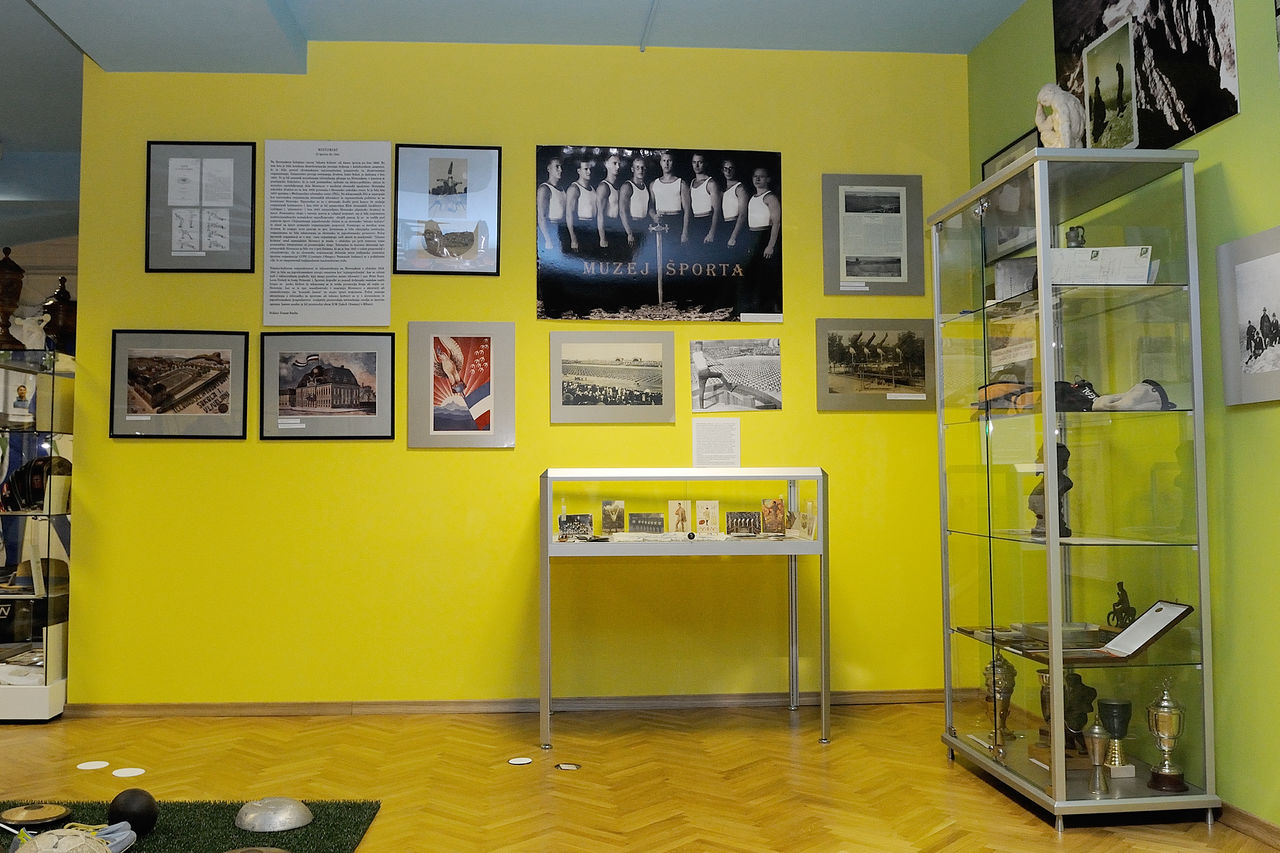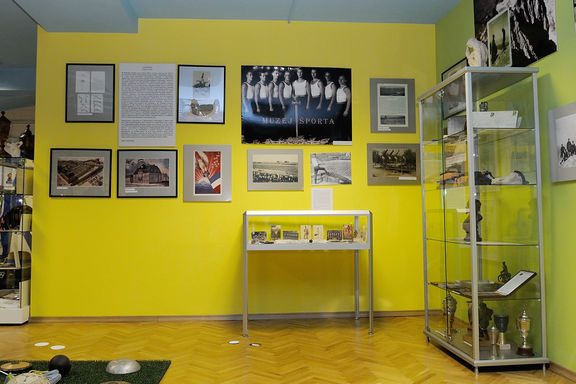Difference between revisions of "Slovene Sports Museum"
(contact change by request) |
Anže Zorman (talk | contribs) (Almost finished, needs some finishing touches) |
||
| Line 1: | Line 1: | ||
{{Article | {{Article | ||
| − | | status = | + | | status = TOPROOFREAD NIFERTIK |
| maintainer = Anže Zorman | | maintainer = Anže Zorman | ||
}} | }} | ||
| Line 12: | Line 12: | ||
| website = http://www.muzejsporta.si | | website = http://www.muzejsporta.si | ||
| founded by = Government of the Republic of Slovenia | | founded by = Government of the Republic of Slovenia | ||
| − | | managed by = Institute of Sports of the Republic of Slovenia | + | | managed by = Planica Institute of Sports of the Republic of Slovenia |
| opening hours = Weekdays 9am - 2pm. Sat, Sun and holidays closed. | | opening hours = Weekdays 9am - 2pm. Sat, Sun and holidays closed. | ||
| contacts = {{Contact | | contacts = {{Contact | ||
| name = Tomaž Pavlin | | name = Tomaž Pavlin | ||
| − | | role = Head | + | | role = Head of the museum |
| + | | email = | ||
| + | | telephone = | ||
| + | }} | ||
| + | {{Contact | ||
| + | | name = Aleš Šafarič | ||
| + | | role = Museum curator and researcher | ||
| + | | email = | ||
| + | | telephone = | ||
| + | }} | ||
| + | {{Contact | ||
| + | | name = Gabrijel Gros | ||
| + | | role = Director of the Planica Institute of Sports | ||
| email = | | email = | ||
| telephone = | | telephone = | ||
| Line 24: | Line 36: | ||
{{Teaser| | {{Teaser| | ||
| − | + | Rather small and yet still in development, the [[Slovene Sports Museum]] is the main national institution dedicated to the heritage of sports culture. Housing a permanent exhibition of artefacts, documents, and other records related to sports in Slovenia, the place got established in [[established::2000]]. Its aim is that of collecting, conserving and presenting the relevant artefacts as well as researching the wider field of sports culture and its history. | |
| − | + | The museum is located in the Ljubljana city centre, just next to the marketplace. The entrance, however, is somewhat hard to find and for larger groups it is advisable to announce their visit upfront. | |
| − | + | {{Wide Image|Slovene Sports Museum 2010 Part of the exhibition.jpg}} | |
}} | }} | ||
| + | ==Background and the current situation== | ||
| + | |||
| + | The idea of setting up a museum on sports has been circulating since the 1980s, when some of the materials were already gathered. Formally established in 2000, the smallest and youngest national museum opened its doors two years later. However, in 2013 the museum ceased to function as an independent unit and became a part of the national institute for sports. Under its wing it also helped to set up the [[Planica Museum]], which deals with the history of ski jumps and winter sports in the Alpine valley of Planica. | ||
| + | |||
| + | It should be noted that its permanent exhibition is still under construction – inventorying is in progress; a digital database is being updated; photos, audio, video files and documentary films are being collected and organised. | ||
==Collections== | ==Collections== | ||
| − | + | A significant part of the rich collection of the Slovene Sports Museum was provided via the Faculty of Sport Museum Collection and, since 2004, the Olympic Committee of Slovenia Archives. However, a great number of donations and acquisitions of artefacts have been made by individuals, collectors, athletes, sport workers, and experts, mainly consisting of sport equipment, medals, cups, sport uniforms, etc. New pieces are still gladly accepted. | |
| − | + | The collection, tightly spread out over a 100m2 exhibition space, is extremely varied. One might mention its strong emphasis on winter sports that spans from old hockey equipment to a selection of skis that present the development of their shape and technology. Among them one can find not only original competition skis by the legendary skiers [[Mateja Svet]] and Ingemar Stenmark, but also a reproduction of the skis as used a hundred years ago on the Bloke plains. Some select pieces relating to ski flying are still exhibited here. Others, like the heritage of the ski jump construction engineer [[Stanko Bloudek]], and the Planica collection of [[Svetozar Guček]] (both originally from the Faculty of Sport Museum Collection), were transferred to the newly established [[Planica Museum]] in 2016. | |
| + | The collection presents Slovene sport legends such as [[Mateja Svet]], [[Mitja Petkovšek]], [[Borut Bilač|Borut]] and [[Britta Bilač]], [[Nataša Urbančič]], [[Stanko Lorger]], [[Cveto Pavčič]], [[Bogdan Svet]], [[Mik Pavlovič]], [[Marko Račič]], [[Andrej Jelenc]], and others. | ||
| − | The | + | == Temporary exhibitions == |
| + | |||
| + | The Slovene Sports Museum collaborates with numerous other museums and institutions at different priojects and exhibitions. One of the bigger ones was the setting up of the [Planica Museum]], dedicated to the history of ski jumping and flying, located in a newly constructed pavilion in the framework of the [[:Category:Nordic Centre Planica|Nordic Centre Planica]]. | ||
| − | |||
The Slovene Sports Museum prepares temporary exhibitions that coincide with international sporting events such as the Soccer World Cup 2002, the Olympics and other world championships, as well as those taking place in Slovenia: the European Championship in Waterpolo 2003 in Kranj; the European Championship of Gymnastics for Men in Ljubljana (2004) with an exhibition on [[Miro Cerar]], our most successful Olympic sportsman. | The Slovene Sports Museum prepares temporary exhibitions that coincide with international sporting events such as the Soccer World Cup 2002, the Olympics and other world championships, as well as those taking place in Slovenia: the European Championship in Waterpolo 2003 in Kranj; the European Championship of Gymnastics for Men in Ljubljana (2004) with an exhibition on [[Miro Cerar]], our most successful Olympic sportsman. | ||
In 2003 alongside the 140th anniversary of the founding of the South Sokol Society, a historical exhibition on this legendary group which marked the beginning of sport manifestations, sport clubs, and important political movements in Slovenia from the early 20th century, etc. took place and was visited by over 6,000 people. | In 2003 alongside the 140th anniversary of the founding of the South Sokol Society, a historical exhibition on this legendary group which marked the beginning of sport manifestations, sport clubs, and important political movements in Slovenia from the early 20th century, etc. took place and was visited by over 6,000 people. | ||
| − | |||
| − | |||
| − | |||
| − | |||
==See also== | ==See also== | ||
* [[Planica Museum]] | * [[Planica Museum]] | ||
* [[:Category:Nordic Centre Planica|Nordic Centre Planica]] | * [[:Category:Nordic Centre Planica|Nordic Centre Planica]] | ||
| − | |||
==External links== | ==External links== | ||
* [http://www.muzejsporta.si/ Slovene Sports Museum website] (in Slovenian) | * [http://www.muzejsporta.si/ Slovene Sports Museum website] (in Slovenian) | ||
* [http://www.visitljubljana.si/en/experiences/culture-and-art/1446/detail.html Slovene Sports Museum on Visit Ljubljana website] | * [http://www.visitljubljana.si/en/experiences/culture-and-art/1446/detail.html Slovene Sports Museum on Visit Ljubljana website] | ||
| + | * [https://www.nc-planica.si/en/aktivnost/muzej-planica/ The Planica Museum website] | ||
| + | |||
| + | {{Gallery}} | ||
[[Category:Museums]] | [[Category:Museums]] | ||
[[Category:Sport]] | [[Category:Sport]] | ||
[[Category:National museums]] | [[Category:National museums]] | ||
Revision as of 19:44, 22 March 2017
Background and the current situation
The idea of setting up a museum on sports has been circulating since the 1980s, when some of the materials were already gathered. Formally established in 2000, the smallest and youngest national museum opened its doors two years later. However, in 2013 the museum ceased to function as an independent unit and became a part of the national institute for sports. Under its wing it also helped to set up the Planica Museum, which deals with the history of ski jumps and winter sports in the Alpine valley of Planica.
It should be noted that its permanent exhibition is still under construction – inventorying is in progress; a digital database is being updated; photos, audio, video files and documentary films are being collected and organised.
Collections
A significant part of the rich collection of the Slovene Sports Museum was provided via the Faculty of Sport Museum Collection and, since 2004, the Olympic Committee of Slovenia Archives. However, a great number of donations and acquisitions of artefacts have been made by individuals, collectors, athletes, sport workers, and experts, mainly consisting of sport equipment, medals, cups, sport uniforms, etc. New pieces are still gladly accepted.
The collection, tightly spread out over a 100m2 exhibition space, is extremely varied. One might mention its strong emphasis on winter sports that spans from old hockey equipment to a selection of skis that present the development of their shape and technology. Among them one can find not only original competition skis by the legendary skiers Mateja Svet and Ingemar Stenmark, but also a reproduction of the skis as used a hundred years ago on the Bloke plains. Some select pieces relating to ski flying are still exhibited here. Others, like the heritage of the ski jump construction engineer Stanko Bloudek, and the Planica collection of Svetozar Guček (both originally from the Faculty of Sport Museum Collection), were transferred to the newly established Planica Museum in 2016.
The collection presents Slovene sport legends such as Mateja Svet, Mitja Petkovšek, Borut and Britta Bilač, Nataša Urbančič, Stanko Lorger, Cveto Pavčič, Bogdan Svet, Mik Pavlovič, Marko Račič, Andrej Jelenc, and others.
Temporary exhibitions
The Slovene Sports Museum collaborates with numerous other museums and institutions at different priojects and exhibitions. One of the bigger ones was the setting up of the [Planica Museum]], dedicated to the history of ski jumping and flying, located in a newly constructed pavilion in the framework of the Nordic Centre Planica.
The Slovene Sports Museum prepares temporary exhibitions that coincide with international sporting events such as the Soccer World Cup 2002, the Olympics and other world championships, as well as those taking place in Slovenia: the European Championship in Waterpolo 2003 in Kranj; the European Championship of Gymnastics for Men in Ljubljana (2004) with an exhibition on Miro Cerar, our most successful Olympic sportsman.
In 2003 alongside the 140th anniversary of the founding of the South Sokol Society, a historical exhibition on this legendary group which marked the beginning of sport manifestations, sport clubs, and important political movements in Slovenia from the early 20th century, etc. took place and was visited by over 6,000 people.
See also
External links
- Slovene Sports Museum website (in Slovenian)
- Slovene Sports Museum on Visit Ljubljana website
- The Planica Museum website





